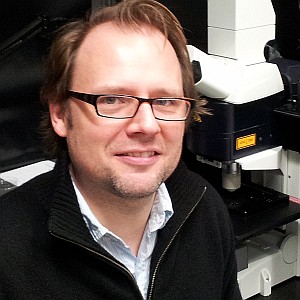Dr. Ingo Thievessen
- Job title: Post-Doc/Projectleader
- Working group: Biophysics Group
- Address:
Room 02.074 - Phone number: +49 9131 85-25606
- Email: ingo.thievessen@fau.de
The role of vinculin in coordinating cellular morphodynamics, force generation and ECM remodeling during cell migration in 2D and 3D environments
Coordinated cell migration is critical for tissue morphogenesis and homeostasis, and requires the integration of actin cytoskeleton based force generation and cell adhesion to the extracellular matrix (ECM) through integrin adhesion receptors. How force generation and ECM-adhesion affect cell motility has mainly been studied using two-dimensional (2D) cell culture substrates, which cannot recapitulate the mechanics of cell migration in vivo, where cells have to overcome the steric hindrance of the ECM to move forward. Three-dimensional (3D) matrices of collagen, fibrin, or cell-derived matrices are being used more frequently. However, how traction force generation, ECM-adhesion and physical parameters of the ECM influence cell migration in 3D environments still remains unclear, and can vary fundamentally between different cell types.
The coordinated migration of cells in vivo is often associated with a remodeling of the ECM, which modulates haptic and mechanical guidance cues for the cells. In turn, excessive ECM-remodeling may promote cell motility in pathological conditions such as cancer metastasis. Cell motion and ECM-remodeling both depend on cellular traction forces, allowing cells to move forward and apply tension to remodel the ECM, suggesting a role for ECM-traction force generation in coordinating cell motion and ECM-remodeling. It remains unknown, however, which cytoskeleton and adhesion proteins are required to coordinate the remodeling of complex 3D matrices.
The adhesion protein vinculin is present in cell-cell junctions and in focal adhesions (FA), where it links filamentous (F-) actin to the integrin-binding protein talin to transmit forces between actin cytoskeleton and ECM. Vinculin reduces cell migration on 2D substrates. In addition, vinculin expression is reduced in a number of human tumors, and cancer cells overexpressing vinculin show reduced metastatic capacity when injected into nude mice, suggesting that vinculin may also inhibit cell migration in vivo. However, vinculin seems to affect 3D cell migration fundamentally different from 2D cell migration, as it promotes the invasion of fibroblasts into 3D collagen gels. It remains unclear though, how vinculin facilitates cell invasion into collagen. The collagen invasiveness of different cancer cells correlated with the strain energy amounts generated by the cells, with the strain energy field anisotropy, and cell shape anisotropy . Vinculin affects both cell morphology and force generation on 2D substrates, suggesting that vinculin may also promote collagen invasion by modulating force generation and cell shape. It is not known, however, how vinculin affects cell morphodynamics, traction force generation, or ECM remodeling in complex 3D environments.
We characterize the effects of vinculin gene disruption on cell migration, morphodynamics, force generation and ECM-remodeling of primary murine embryonic fibroblast (MEF) on 2D substrates and in 3D collagen I culture.
Dr. rer. nat.,summa cum laude, 10/2002 – 04/2007. Mouse Genetics/Cell Biology. Max-Planck-Institute of Biochemistry, Martinsried/Heinrich-Heine-University Duesseldorf, Germany. Prof. Dr. med. Reinhard Faessler
Dipl. Biol., 10/1996 – 04/2002. Cell Biology/Biochemistry/Physics. Heinrich-Heine-University Duesseldorf, Germany. Prof. Dr. rer. nat. Wolfgang Schulz
Scientific Assistant, 03/2012 – present. Friedrich-Alexander University Erlangen-Nuremberg, Chair for Biophysics, Biophysics Group. Prof. Dr. Ben Fabry. Project: The role of vinculin in morphodynamics and force generation of primary murine embryonic fibroblasts and endothelial cells in 3D collagen matrices and in vivo
Postdoctoral Fellow, 09/2007 – 02/2012. National, Heart, Lung and Blood Institute/National Institutes of Health, Cell Biology and Physiology Center, Laboratory of Cell and Tissue Morphodynamics. Prof. Dr. Clare M. Waterman, Ph.D.. Project: The role of vinculin in actin based force generation by focal adhesions in migrating primary murine embryonic fibroblasts
Postdoctoral Fellow, 05/2007 – 08/2007. The Scripps Research Institute, Department of Cell Biology, Cell Motility Group. Prof. Dr. Clare M. Waterman, Ph.D.. Project: The role of vinculin in actin based force generation by focal adhesions in migrating primary murine embryonic fibroblasts
Doctoral Student, 10/2002 – 04/2007. Department of Molecular Medicine, Max-Planck-Institute of Biochemistry, Martinsried. Prof. Dr. med. Reinhard Faessler. Project: Functional analysis of focal adhesion proteins of the parvin family by knockout in the mouse
Diploma Student, 03/2001 – 03/2002. Research Laboratory of the Urological Clinic, Heinrich-Heine-University Duesseldorf. Prof. Dr. rer. nat. Wolfgang A. Schulz. Project: Basic and inducible activities of the Wnt- and Hedgehog-signaltransduction pathways in normal and transformed uroepithelial cells
Undergraduate Student, 03/2000 – 12/2000. Department of Cell Biology, Institute of Zoomorphology, Cell Biology and Parasitology, Heinrich-Heine-University Duesseldorf. Prof. Dr. rer. nat. Jochen D´Haese. Project: Identification of flea populations by sequence analysis of the internal ribosomal spacer region 1
Course Assistant “Biomedical Imaging”, Department of Physics, Biophysics Group, Friedrich-Alexander University Erlangen-Nuermberg. 2014
Course Assistant “Experimental Physics”, Department of Physics, Biophysics Group, Friedrich-Alexander-University Erlangen-Nuremberg. 2012/2013
Teaching Assistant “Physiology Course”, Marine Biological Laboratory, Woods Hole. 2011
Teaching Assistant “Optical Microscopy and Imaging in the Biomedical Sciences”, Marine Biological Laboratory, Woods Hole. 2007
Course Assistant “Animal Morphology”, Institute of Zoomorphology, Cell Biology and Parasitology, Heinrich-Heine-University Duesseldorf. 2000
Projektleiter nach GenTSV, Friedrich-Alexander University Erlangen-Nuermberg, Chair for Physical and Medical Technology. 2013
Attendance at laboratory safety/operational courses, Projektleiter nach GenTSV, Sondermuell, Brandgefahren. 2013
National Heart, Lung and Blood Institute Fellows Advisory Committee Member, National Heart, Lung and Blood Institute/National Institutes of Health, Bethesda. 2010-2012
American Society for Cell Biology Member, since 2007
Travel Grant, 53rd Annual Meeting of the American Society for Cell Biology, New Orleans, 2013
Travel Grant, Swedish Association for Cytoskeleton Research meeting “The Cytoskeleton in Development and Pathology”, Federation of the Societies of Biochemistry and Molecular Biology (FEBS)”. 2010
Fellows Award for Research Excellence 2010, National Institutes of Health, Bethesda. 2009


